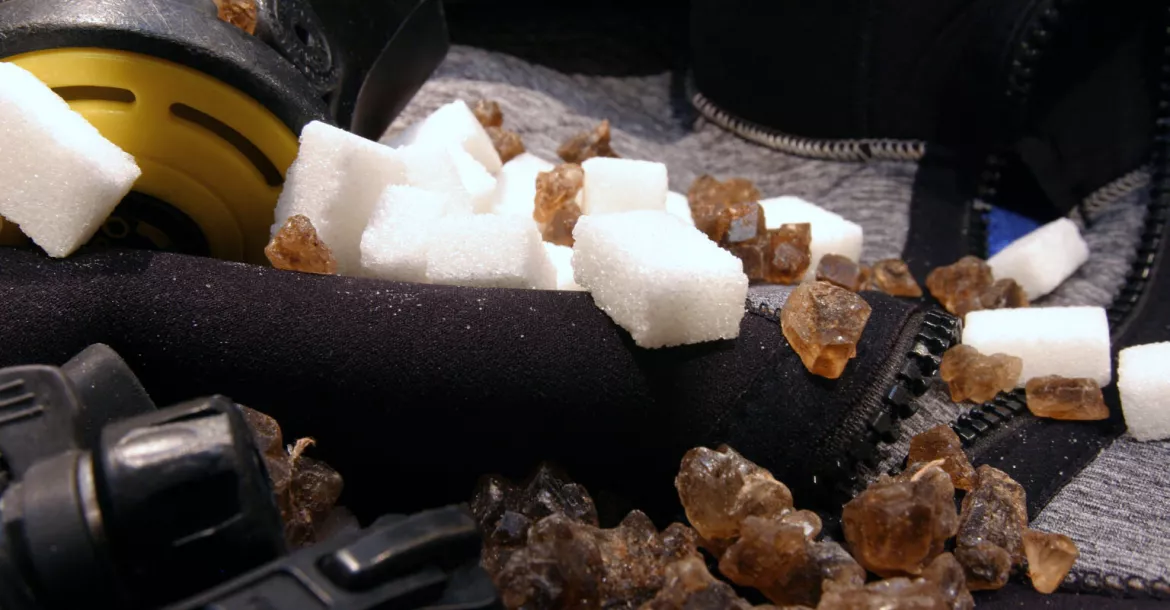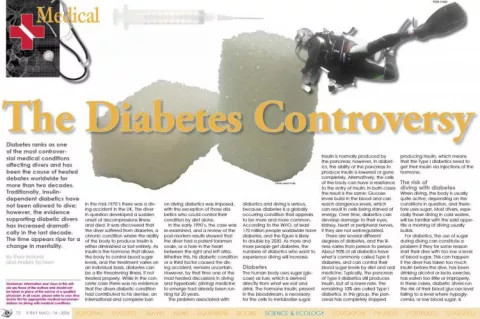Diabetes ranks as one of the most controversial medical conditions affecting divers and has been the cause of heated debates worldwide for more than two decades.
Contributed by
Factfile
About the author
Thea Brolund is a Type I diabetic, She is a multiple-award winning PhD-candidate at the School of Marine Biology at the University of Technology, Sydney in Australia. She is a diver with several years of marine biological scientific fieldwork behind her. She manages her diabetes through a combination of insulin injections and an AustralAsian Medical and Scientific Limited Animas 1000 insulin pump (the combination is often called the “un-tethered” approach, and is used by many active diabetics).
Brolund was the first Danish Type I diabetic to gain permission to dive, and presented her initial experiences at the EUBS 2003 hyperbaric medicine conference. She fought for a year to gain the same diving rights in Australia as in Denmark, and is currently a registered diver at two different Australian research institutions. She remains actively engaged in the effort to insure diabetics the right to dive globally.
Diabetes ranks as one of the most controversial medical conditions affecting divers and has been the cause of heated debates worldwide for more than two decades. Traditionally, insulin-dependent diabetics have not been allowed to dive; however, the evidence supporting diabetic divers has increased dramatically in the last decade. The time appears ripe for a change in mentality.
In the mid-1970´s there was a diving accident in the UK. The diver in question developed a sudden onset of decompressions illness and died. It was discovered that the diver suffered from diabetes, a chronic condition where the ability of the body to produce insulin is either diminished or lost entirely. As insulin is the hormone that allows the body to control blood sugar levels, and the treatment varies on an individual basis, diabetes can be a life threatening illness, if not treated properly.
While in the concrete case there was no evidence that the divers diabetic condition had contributed to his demise, an international and complete ban on diving diabetics was imposed, with the exception of those diabetics who could control their condition by diet alone.
In the early 1990’s, the case was re-examined, and a review of the post-mortem results showed that the diver had a patent foramen ovale, or a hole in the heart between the right and left atria. Whether this, his diabetic condition or a third factor caused the diving accident, remains uncertain. However, by that time one of the most heated discussions in diving and hyperbaric (diving) medicine to emerge had already been running for 20 years.
The problem associated with diabetics and diving is serious, because diabetes is a globally occurring condition that appears to be more and more common. According to the WHO, at least 170 million people worldwide have diabetes, and the figure is likely to double by 2030. As more and more people get diabetes, the numbers of diabetics who want to experience diving will increase.
Diabetes
The human body uses sugar (glucose) as fuel, which is derived directly from what we eat and drink. The hormone insulin, present in the bloodstream, is necessary for the cells to metabolize sugar. Insulin is normally produced by the pancreas; however, in diabetics, the ability of the pancreas to produce insulin is lowered or gone completely. Alternatively, the cells of the body can have a resistance to the entry of insulin. In both cases the result is the same: Glucose levels build in the blood and can reach dangerous levels, which can result in cells being starved of energy. Over time, diabetics can develop damage to their eyes, kidney, heart or peripheral nerves, if they are not well-regulated.
There are several different degrees of diabetes, and the illness varies from person to person. About 90% of all diabetics have what is commonly called Type II diabetes, and can control their blood sugar levels by diet and oral medicine. Typically, the pancreas of Type II diabetics still produces insulin, but at a lower rate. The remaining 10% are called Type I diabetics. In this group, the pancreas has completely stopped producing insulin, which means that the Type I diabetics need to get their insulin via injections of the hormone.
The risk of diving with diabetes
When diving, the body is usually quite active, depending on the conditions in question, and therefore uses sugar. Most divers, especially those diving in cold waters, will be familiar with the solid appetite a morning of diving usually builds.
For diabetics, the use of sugar during diving can constitute a problem if they for some reason start their dive with too low a level of blood sugar. This can happen if the diver has taken too much insulin before the dive, has been drinking alcohol or lacks exercise, has eaten too little or improperly. In these cases, diabetic divers run the risk of their blood glucose level falling to a level where hypoglycemia, or low blood sugar, is precipitated. A hypoglycemia episode can, dependent on the severity, cause everything from mild headaches to weakness, tremor, sweatiness or chilling, irritability, alterations or loss of consciousness to convulsions. Needless to say, the extreme end of these effects is highly dangerous in a diving situation.
A convoluted problem
The risk of developing hypoglycemia has been the primary factor in the medical establishment having traditionally banned Type I diabetics from diving. Not only does a severe hypoglycemia episode endanger the diabetic, it can potentially endanger their dive buddies as well.
However, during the early 1990’s it was gradually realized that hypoglycemia while underwater or on the surface appeared to be much less common than what was popularly believed. Furthermore, it was realized that the diabetics were diving despite the ban. Diabetics, already frustrated by the way society tends to view them as walking chronic conditions rather than human beings, which seems to be a common fate for people who have some sort of disability or other, basically disregarded the recommendation of the hyperbaric doctors.
To back up their case, the predicted cases of hypoglycemic-induced diving accidents never materialized. A survey was carried out on diabetic divers, and this showed that none of these had suffered from an increased incidence of decompression illness, or more importantly, none suffered from hypoglycemic attacks while diving.
This caused a problem for the medical establishment. On one hand, the doctors lacked sufficient knowledge about diabetes and diving (i.e. the effect of pressure change on e.g. blood sugar absorption) to approve diabetics for diving, and on the other they did not want diabetics to dive without at least proper instruction in how to handle their condition. Furthermore, as many diabetics feared being banned from diving, they kept silent about their condition.
Early investigations
In 1992, the British Sub-Aqua Club (BSAC) decided to readmit Type I and other diabetics into the club, providing that they fulfill a set of strict medical criteria, including excellent control of their blood sugar levels through insulin injections. At the same time, data from diabetic divers started being collected in the UK.
In 1996, the Undersea and Hyperbaric Medical Society (UHMS) chaired a workshop focused on discussing the issue of diabetic divers. Researchers debated the evidence at hand and discussed the possibility of loosening the ban on divers with insulin-dependent diabetes.
At the UHMS meeting, Divers Alert Network (DAN), an international diving safety organization, reported that out of 550 dive-related fatalities occurring from 1989 to 1994, seven had diabetes. However, whether their condition contributed to their cause of death was not clear. Furthermore, eight of 2,400 episodes of decompression illness involved diabetic divers. Both numbers were in line with the expected numbers in the general population, and therefore the statistics failed to show an increasing risk for diabetic divers.
Furthermore, DAN carried out a survey in early 1996, where 164 diabetic divers replied. Of the 164, 129 were Type I diabetics—and had participated in over 27,000 dives with no major complications. A few reported having experienced symptoms of hypoglycemia, but none reported the loss of consciousness that caused the ban on diabetic divers in the first place. Other studies were carried out, and e.g. the Camp DAVI project, carried out by Dr. George Burghen and Stephen Prosterman in the US Virgin Islands, reported similar positive results in detailed studies of 32 insulin-dependent divers.
In parallel with the new evidence on diabetes and diving, the medical industries had developed more effective insulin types and delivery systems. Including fast and slow-acting insulin types. While Type I diabetics in the 1970’s used measurements of the sugar level in their urine to calculate how much insulin they should take, modern equipment allows measurement of blood sugar directly, in as little as 30 seconds. This has facilitated unprecedented levels of control of blood sugar levels.
The ban is loosened
With the evidence slowly mounting in favor of the diabetic divers, several countries began lifting the band on diabetic diving, including the UK, USA, Sweden and Egypt. Other countries began to inquire about the standards utilized by these countries, including Australia, Holland and Denmark. In the countries that lifted the ban on diabetic diving around this time, medical guidelines similar to those used in the UK were enforced, which ensured that only fit, well-regulated Type I diabetics would gain dive clearance.
Furthermore, standards and guides were developed to assist the diabetic, outlining e.g. how to ensure stable blood sugar levels before, during and after each dive. In general, these guidelines were developed in collaboration with the diabetic divers and based in part on their experiences and solutions; e.g. DAN, UHMS and BSAC all have protocols for approving diabetic divers. As of 2000, most countries still enforced the ban, however.
New evidence
From 1997 through 1999, DAN took to the field again, collecting data from more than 500 dives by insulin-requiring divers and a similar amount of control dives by divers without diabetes. There were no adverse effects due to diving on the diver with diabetes—even with 18 hypoglycemic episodes outside of the diving.
In 2001, a group of UK-based doctors published the experiences with diabetic divers in the UK since the lift of the ban.
Due to an excellent collaboration between divers and their physicians, the UK had amassed a substantial body of evidence on the subject, including data from 323 diabetic divers performing 8,760 divers over 11 years. In that time span, two fatalities were recorded, both in non-insulin dependent divers, and only one incident of hypoglycemia underwater in an insulin-dependent diabetic was reported.
The study showed that in the group of well-controlled diabetic divers, there were no serious problems due to hypoglycemia when they dived; however, the study concluded that diabetics suffering long-term complications of their conditions, such as heart problems, should not dive. More evidence accrued, and was presented at the 2005 DAN workshop on diabetes and recreational diving.
The workshop resulted in the publication of a set of standardized guidelines for allowing diabetics who use medication, to dive. The guidelines consist of 19 points, and include e.g. the requirements about the age and fitness of the diabetic, with one of the primary requirements being no hypoglycemic episodes, requiring intervention from a third party, within the past 12 months. Additionally, the diabetic should carry extra reserves of blood glucose with them during the dive.
The problem continues
To the continued frustration of diabetics, the absolute ban on divers with insulin requiring diabetes remains under review and country specific, although more and more countries are lifting the ban. Strangely, the problem appears to be not so much related to the question of whether Type I diabetics are at increased risk when diving or not, but rather a question of responsibility.
Extreme sports, like diving and rock climbing, carry with them an inherent risk for the practitioner and those he or she climbs or dives with. However, traditionally most of these sports have not required any kind of medical clearance—i.e., there is none to prevent people from rock climbing, irrespective of any health problems. This may in part have something to do with the fact that the dangers associated with rock climbing are obvious and under the domain of common sense.
The dangers associated with diving—nitrogen pressure, ear squeezes and similar however, need to be taught. Despite the obvious parallel between diving and other extreme sports, diving has always been associated with medical clearances given by doctors. This means that divers have fallen under a “paternalistic medicine” that tells them what they can and cannot do. Needless to say, diabetics, already plagued in this regard, have rebelled against this.
It is however too easy to blame the doctors, for the problem is complex, and related to the phrase “fitness to dive” which is what a medical practitioner must agree to when clearing a diver for diving. In some countries, the medical clearance of “fitness to dive” has achieved legal standing, and this means that the medical practitioner takes a very real risk of getting blamed in case something goes wrong with the cleared diver.
On the other hand, the responsibility of declaring a person fit to dive can be delegated to the dive instructor. In both cases, the involved people develop a natural fear of accepting the risk.
The problem with the situations is that the diabetic who actually wants to dive cannot take the risk upon himself—which is what a rock climber can do. With diabetic divers willing to take the risk of diving upon themselves, and practitioners of other extreme sports not having this problem, it is a valid point to ask by the divers, instructors and practitioners alike why so many countries still prevent diabetics from diving.
In summary, scientific evidence points to the fact that the ban on diabetic diving was erroneously imposed, and excellent collaborations between diabetics, medical experts and instructors have helped develop good international guidelines for diabetics who wish to dive.
However, as yet many countries still in practice do not allow Type I diabetics to dive (e.g. Australia), and the diabetes controversy is like to continue with diabetics (and other groups similarly affect e.g. as reported for Australia by a study from 2002) diving illegally, and outside the ability of the medical establishment to monitor their situation, until the day that the ban is lifted in these countries. ■






























